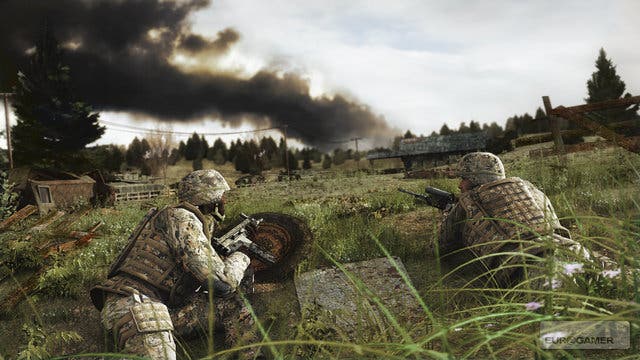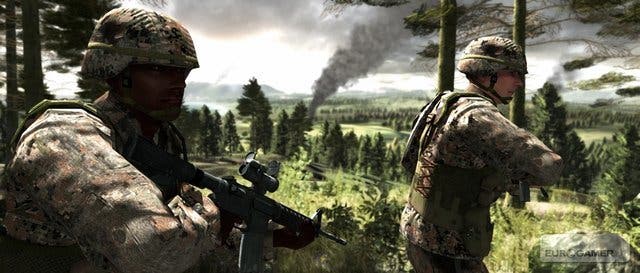Operation Flashpoint 2: Dragon Rising
Chasing dreams.
But unlike the rather rudimentary visuals of old, this time Codies has gone to extreme lengths to ensure the game is technically well up to scratch. "The environment itself is actually very detailed," Lindop stresses, "And that's where a lot of the technological effort has gone." He points to "clever streaming technology" that enables the level designers to come up with rich environments with a lot of natural and man-made cover.
"There's a density of trees, buildings and structures so that not only are you in this scale of environment, but there's actually stuff in it. One of the problems in the original in that you had this huge scale, but nothing in it, so you'd be stood out in this open area all the time and get shot." Anyone who played it should relate to that.
"The game still has that degree of realism and toughness," declares Lindop, "But now you've actually got a realistic environment. Now you're not just getting shot dead by a magic bullet from two kilometres away, you can use these folds in the ground - the different flora and fauna and different environments to give you cover and make your approach"
And then, of course, there's the game's AI - slightly off kilter in the original, you may recall. "We have to develop an AI that'll be able to read the environment and make tactical decisions about the environment: this is an ambush spot, this is a good place for hiding myself from the enemy and flanking," says Lindop. "All of these things work together to make the environment. Rather than just make it a pretty setting for the action it's an absolute part of the tactical choices you make and why you go certain routes."

But the AI doesn't just figure out routes based on the environment. A whole host of other factors will also come into play, including a morale system and a suppression system. "The AI figures everything else out for itself and does so on the fly," he says. "People don't fire to kill in combat. They fire a lot of bullets to make the other guy hide. If you're lucky, you'll kill him, and you need to reflect that in this game because at that range, and with that calibre, you might kill him, but mainly you want him to piss off, sort of run away and hide." Meanwhile, if you're being an idiot and putting your squad mates at risk, the AI is smart enough that they'll end up going their own way.
Apparently you can expect to "spend a lot of time in the infantry right on the ground", which means "the detail has to be there". So, Codies has gone to great lengths to ensure the environment "offers tactical challenges in a whole series of ways". Think different lighting conditions, such as smoke and dust-filled rooms, or sorties under the cover of darkness or in extreme weather - all of which promise to make us understand why the military uses enhanced vision systems in the first place.
Advanced levels of destructibility are also high on the agenda. "Everything is destructible - and it's persistent. Once it's gone, it's gone, and there's a reason for that. You have to actually be careful what you blow up, because if I blow up building X one mission, I might have really needed that building in the next mission for cover and I've blown it. So you've really got to think when you're dropping 2,000 pound bombs everywhere. These all add extra tactical challenges."

Following this quest for realism, we're shown a screen with a vast array of individually modeled solder heads, so that each has a distinct look. In the heat of battle, such attention to detail might prove invaluable - as, of course, it would in real-life. "We built as many individual characters as possible. Part of the intuitive way of giving commands and orders is if I can recognise each individual element. I can see that someone's holding the same machine gun.
"Also, with the kit, if I look at an enemy, I can actually see what his role is - it's pretty much what a sniper does. There's an officer: he's the guy with the radio. There's the machine gunner. You can actually see what people's roles are. It's much easier to give them orders and identify people as enemies," Lindop points out. "So, all of this kind of detail has a practical function. It's about making you use the UI as little as possible because a real soldier doesn't know who you are. He sits there and looks at the environment, looks at the world then gathers information."

